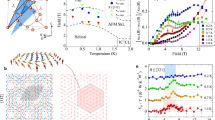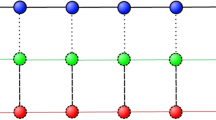Abstract
Common wisdom about conventional antiferromagnets is that their low-energy physics is governed by spin–wave excitations. However, recent experiments on several cuprate compounds have challenged this concept. An enhanced thermal Hall response in the pseudogap phase was identified, which persists even in the insulating parent compounds without doping. Here, to explain these surprising observations, we study the quantum phase transition of a square-lattice antiferromagnet from a confining Néel state to a state with coexisting Néel and semion topological order. The transition is driven by an applied magnetic field and involves no change in the symmetry of the state. The critical point is described by a strongly coupled conformal field theory with an emergent global SO(3) symmetry. The field theory has four different formulations in terms of SU(2) or U(1) gauge theories, which are all related by dualities; we relate all four theories to the lattice degrees of freedom. We show how proximity of the confining Néel state to the critical point can explain the enhanced thermal Hall effect seen in experiments.
This is a preview of subscription content, access via your institution
Access options
Access Nature and 54 other Nature Portfolio journals
Get Nature+, our best-value online-access subscription
$29.99 / 30 days
cancel any time
Subscribe to this journal
Receive 12 print issues and online access
$209.00 per year
only $17.42 per issue
Buy this article
- Purchase on Springer Link
- Instant access to full article PDF
Prices may be subject to local taxes which are calculated during checkout




Similar content being viewed by others
Data availability
The data that support the plots within this paper and other findings of this study are available from the corresponding author on reasonable request.
Change history
26 January 2021
A Correction to this paper has been published: https://doi.org/10.1038/s41567-021-01180-9
References
Kasahara, Y. et al. Unusual thermal Hall effect in a Kitaev spin liquid candidate α-RuCl3. Phys. Rev. Lett. 120, 217205 (2018).
Grissonnanche, G. et al. Giant thermal Hall conductivity in the pseudogap phase of cuprate superconductors. Nature 571, 376–380 (2019).
Samajdar, R., Chatterjee, S., Sachdev, S. & Scheurer, M. S. Thermal Hall effect in square-lattice spin liquids: a Schwinger boson mean-field study. Phys. Rev. B 99, 165126 (2019).
Kalmeyer, V. & Laughlin, R. B. Equivalence of the resonating-valence-bond and fractional quantum Hall states. Phys. Rev. Lett. 59, 2095–2098 (1987).
Benini, F., Hsin, P.-S. & Seiberg, N. Comments on global symmetries, anomalies, and duality in (2 + 1)d. J. High. Energy Phys. 04, 135 (2017).
Aharony, O. Baryons, monopoles and dualities in Chern–Simons-matter theories. J. High. Energy Phys. 02, 093 (2016).
Hsin, P.-S. & Seiberg, N. Level/rank duality and Chern–Simons-matter theories. J. High. Energy Phys. 09, 095 (2016).
Aharony, O., Benini, F., Hsin, P.-S. & Seiberg, N. Chern–Simons-matter dualities with SO and USp gauge groups. J. High. Energy Phys. 02, 072 (2017).
Sen, D. & Chitra, R. Large-U limit of a Hubbard model in a magnetic field: chiral spin interactions and paramagnetism. Phys. Rev. B 51, 1922–1925 (1995).
Kitaev, A. Anyons in an exactly solved model and beyond. Ann. Phys. 321, 2–111 (2006).
Bauer, B. et al. Chiral spin liquid and emergent anyons in a kagome lattice Mott insulator. Nat. Commun. 5, 5137 (2014).
He, Y.-C. & Chen, Y. Distinct spin liquids and their transitions in spin-1/2 XXZ kagome antiferromagnets. Phys. Rev. Lett. 114, 037201 (2015).
Haghshenas, R., Gong, S.-S. & Sheng, D. Single-layer tensor network study of the Heisenberg model with chiral interactions on a kagome lattice. Phys. Rev. B 99, 174423 (2019).
Hu, W.-J., Gong, S.-S. & Sheng, D. N. Variational Monte Carlo study of chiral spin liquid in quantum antiferromagnet on the triangular lattice. Phys. Rev. B 94, 075131 (2016).
Wietek, A. & Läuchli, A. M. Chiral spin liquid and quantum criticality in extended S =1/2 Heisenberg models on the triangular lattice. Phys. Rev. B 95, 035141 (2017).
Saadatmand, S. N. & McCulloch, I. P. Detection and characterization of symmetry-broken long-range orders in the spin-1/2 triangular Heisenberg model. Phys. Rev. B 96, 075117 (2017).
Gong, S.-S., Zhu, W., Zhu, J. X., Sheng, D. N. & Yang, K. Global phase diagram and quantum spin liquids in a spin-1/2 triangular antiferromagnet. Phys. Rev. B 96, 075116 (2017).
Szasz, A., Motruk, J., Zaletel, M. P. & Moore, J. E. Observation of a chiral spin liquid phase of the Hubbard model on the triangular lattice: a density matrix renormalization group study. Preprint at https://arxiv.org/abs/1808.00463 (2018).
Nielsen, A. E. B., Sierra, G. & Cirac, J. I. Local models of fractional quantum Hall states in lattices and physical implementation. Nat. Commun. 4, 2864 (2013).
Wang, C., Nahum, A., Metlitski, M. A., Xu, C. & Senthil, T. Deconfined quantum critical points: symmetries and dualities. Phys. Rev. X 7, 031051 (2017).
Cappelli, A., Huerta, M. & Zemba, G. R. Thermal transport in chiral conformal theories and hierarchical quantum Hall states. Nucl. Phys. B 636, 568–582 (2002).
Affleck, I. & Marston, J. B. Large-n limit of the Heisenberg–Hubbard model: implications for high-T c superconductors. Phys. Rev. B 37, 3774–3777 (1988).
Affleck, I., Zou, Z., Hsu, T. & Anderson, P. W. SU(2) gauge symmetry of the large-U limit of the Hubbard model. Phys. Rev. B 38, 745–747 (1988).
Wen, X. G., Wilczek, F. & Zee, A. Chiral spin states and superconductivity. Phys. Rev. B 39, 11413–11423 (1989).
Wen, X.-G. Quantum orders and symmetric spin liquids. Phys. Rev. B 65, 165113 (2002).
Scheurer, M. S. & Sachdev, S. Orbital currents in insulating and doped antiferromagnets. Phys. Rev. B 98, 235126 (2018).
Qin, T., Niu, Q. & Shi, J. Energy magnetization and the thermal Hall effect. Phys. Rev. Lett. 107, 236601 (2011).
Sachdev, S. Nonzero-temperature transport near fractional quantum Hall critical points. Phys. Rev. B 57, 7157–7173 (1998).
Witten, E. Fermion path integrals and topological phases. Rev. Mod. Phys. 88, 035001 (2016).
Seiberg, N., Senthil, T., Wang, C. & Witten, E. A duality web in 2 + 1 dimensions and condensed matter physics. Ann. Phys. 374, 395–433 (2016).
Seiberg, N. & Witten, E. Gapped boundary phases of topological insulators via weak coupling. Prog. Theor. Exp. Phys. 2016, 12C101 (2016).
Cordova, C., Freed, D. S., Tat Lam, H. & Seiberg, N. Anomalies in the space of coupling constants and their dynamical applications I. Preprint at https://arxiv.org/abs/1905.09315 (2019).
Zhang, S.-C. The Chern–Simons–Landau–Ginzburg theory of the fractional quantum Hall effect. Int. J. Mod. Phys. B 06, 25–58 (1992).
Lee, J. Y., Wang, C., Zaletel, M. P., Vishwanath, A. & He, Y.-C. Emergent multi-flavor qed3 at the plateau transition between fractional Chern insulators: applications to graphene heterostructures. Phys. Rev. X 8, 031015 (2018).
Barkeshli, M. & McGreevy, J. A continuous transition between fractional quantum Hall and superfluid states. Phys. Rev. B 89, 235116 (2014).
Jain, J. K. Composite-fermion approach for the fractional quantum Hall effect. Phys. Rev. Lett. 63, 199–202 (1989).
Chen, W., Fisher, M. P. A. & Wu, Y.-S. Mott transition in an anyon gas. Phys. Rev. B 48, 13749–13761 (1993).
Sachdev, S., Metlitski, M. A., Qi, Y. & Xu, C. Fluctuating spin density waves in metals. Phys. Rev. B 80, 155129 (2009).
Sachdev, S., Scammell, H. D., Scheurer, M. S. & Tarnopolsky, G. Gauge theory for the cuprates near optimal doping. Phys. Rev. B 99, 054516 (2019).
Chakravarty, S., Halperin, B. I. & Nelson, D. R. Two-dimensional quantum Heisenberg antiferromagnet at low temperatures. Phys. Rev. B 39, 2344–2371 (1989).
Haghshenas, R. & Sheng, D. N. U(1)-symmetric infinite projected entangled-pair states study of the spin-1/2 square J 1 − J 2 Heisenberg model. Phys. Rev. B 97, 174408 (2018).
Wang, L. & Sandvik, A. W. Critical level crossings and gapless spin liquid in the square-lattice spin-1/2 J 1 − J 2 Heisenberg antiferromagnet. Phys. Rev. Lett. 121, 107202 (2018).
Senthil, T., Vishwanath, A., Balents, L., Sachdev, S. & Fisher, M. P. A. Deconfined quantum critical points. Science 303, 1490–1494 (2004).
Sreejith, G. J., Powell, S. & Nahum, A. Emergent SO(5) symmetry at the columnar ordering transition in the classical cubic dimer model. Phys. Rev. Lett. 122, 080601 (2019).
Tanaka, A. & Hu, X. Many-body spin Berry phases emerging from the π-flux state: competition between antiferromagnetism and the valence-bond-solid state. Phys. Rev. Lett. 95, 036402 (2005).
Senthil, T. & Fisher, M. P. A. Competing orders, nonlinear sigma models, and topological terms in quantum magnets. Phys. Rev. B 74, 064405 (2006).
Gorbenko, V., Rychkov, S. & Zan, B. Walking, weak first-order transitions, and complex CFTs. J. High. Energy Phys. 10, 108 (2018).
Ma, H. & He, Y.-C. Shadow of complex fixed point: approximate conformality of Q > 4 Potts model. Phys. Rev. B 99, 195130 (2019).
Acknowledgements
This research was supported by the National Science Foundation under grant no. DMR-1664842. S.C. acknowledges support from the ERC synergy grant UQUAM. M.S.S. acknowledges support from the German National Academy of Sciences Leopoldina through grant no. LPDS 2016-12. We thank N. Seiberg for explaining many subtle aspects of the non-Abelian dualities to us. We thank G. Grissonnanche, Y.-C. He, C. Hickey, C.-M. Jian, P. A. Lee, A. Nahum, L. Taillefer and L. Zou for helpful discussions.
Ethics declarations
Competing interests
The authors declare no competing interests.
Additional information
Publisher’s note Springer Nature remains neutral with regard to jurisdictional claims in published maps and institutional affiliations.
Supplementary information
Supplementary Materials
Supplementary Fig. 1, text and references.
Rights and permissions
About this article
Cite this article
Samajdar, R., Scheurer, M.S., Chatterjee, S. et al. Enhanced thermal Hall effect in the square-lattice Néel state. Nat. Phys. 15, 1290–1294 (2019). https://doi.org/10.1038/s41567-019-0669-3
Received:
Accepted:
Published:
Issue Date:
DOI: https://doi.org/10.1038/s41567-019-0669-3
This article is cited by
-
Giant phonon anomalies in the proximate Kitaev quantum spin liquid α-RuCl3
Nature Communications (2021)
-
Thermal Hall conductivity in the cuprate Mott insulators Nd2CuO4 and Sr2CuO2Cl2
Nature Communications (2020)
-
Chiral phonons in the pseudogap phase of cuprates
Nature Physics (2020)
-
Metastable vacua in large-N QCD3
Journal of High Energy Physics (2020)



